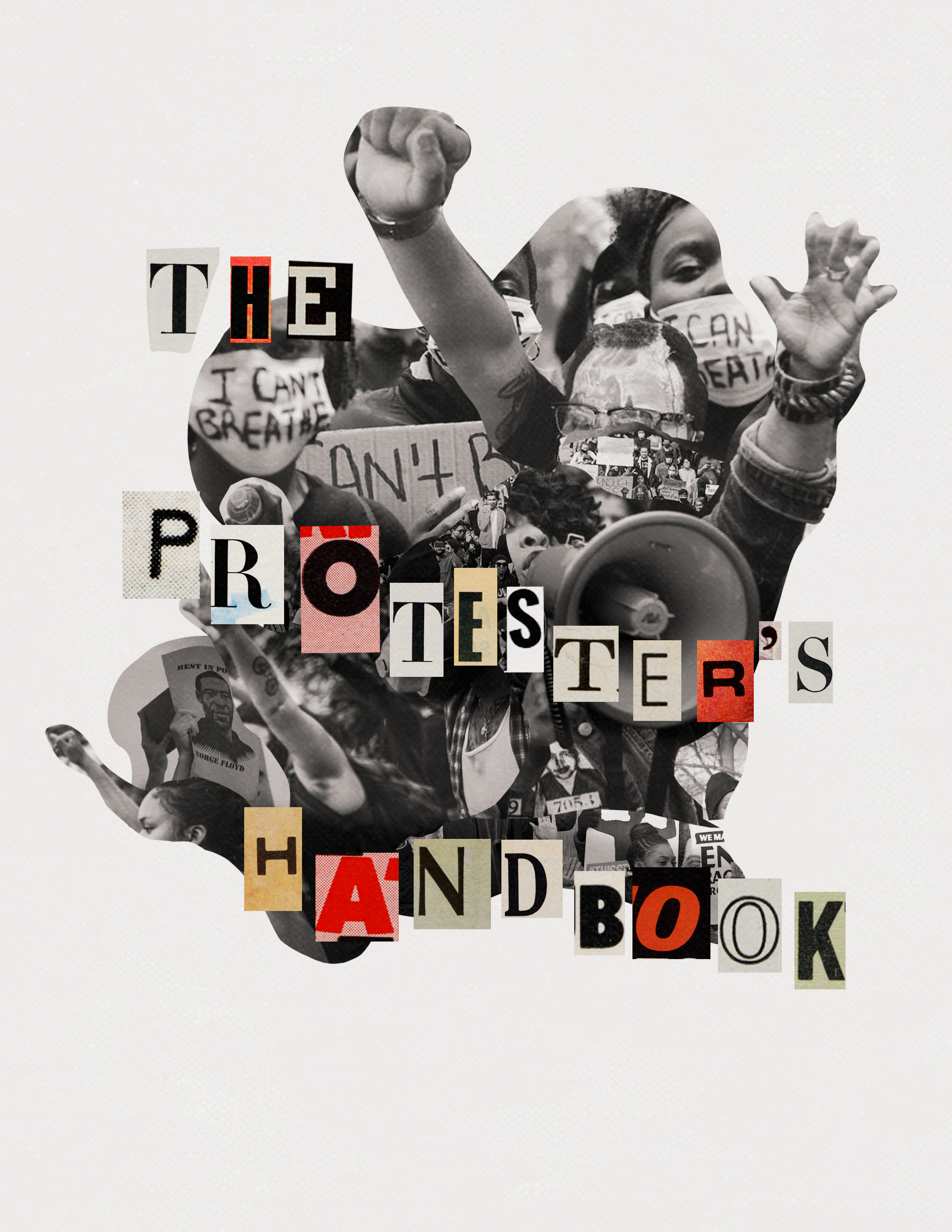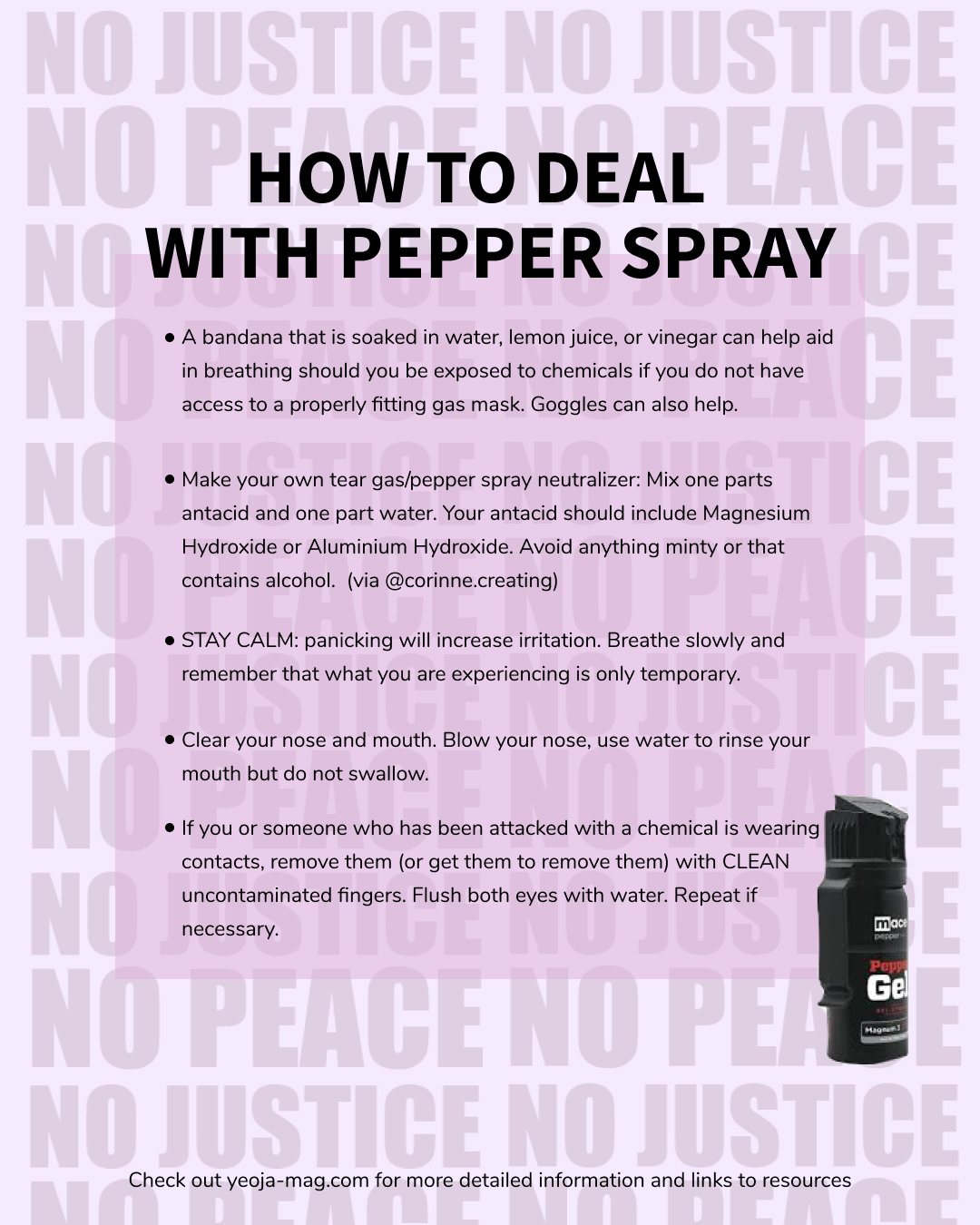Born Angela Yvonne Davis in 1944, the Birmingham, Alabama native came face-to-face with racism at…
The Protestor’s Handbook
A practical guide to safe and effective protesting2 June 2020
On the same day that Amy Cooper weaponised her whiteness against Christian Cooper (no relation), 1200 miles away, a white Minneapolis police officer placed his knee on George Floyd’s neck for 8 minutes and 46 seconds on the pavement, ending his life.
2 minutes and 53 seconds of those 8 minutes and 46 seconds occurred after Floyd was unresponsive. These two incidents highlight the level of systemic racism, violence, and power imbalance embedded in the fabric of America. A day later, on the 26th of May, a makeshift memorial was created at the bus stop which was the site of Floyd’s murder. Hours later, more and more people filled the area to demonstrate against the crime. Since then, numerous demonstrations have sprung up all over the country, with America experiencing it’s sixth night of mass demonstrations and civil unrest
Mass demonstrations are a natural and logical response to systemic oppression and violence. While systemic oppression and violence against black people in America is nothing new (the first enslaved Africans were forcibly brought to North America as early as the 1500s), and America has gone through different waves of protest against the inhumane treatment of black Americans (the civil rights movement, the Black Power movement, the Black feminist movement of the 1980s, Black Lives Matter) we are once again seeing the emergence of a new movement as the system is still categorically and inherently racist and violent.
Mass demonstrations are the first step towards systemic reform, so it should come as no surprise that many with vested interests in an inherently imbalanced system will do whatever it takes to undermine your voice. We have put together a guide which can aid you in both protesting safely and effectively.* (Download the pdf version here.)

How to prepare
- Find yourself a Bail Buddy: Prepare for the worst. You might be arrested; at least 4,100 people in U.S. cities over the weekend already have been. Make sure you inform a trusted family member or a friend that is NOT at the protest of where you will be. Make sure they have your full name, birthday, and medical conditions so that they can be a Bail Buddy if you get arrested. The ACLU also suggests making arrangements with a lawyer in advance if possible.
- Have the numbers you need: Get out your sharpie and write down the chapter of the National Lawyers’ Guild on your arm in permanent marker.
- Know your Rights: The ACLU and Amnesty International have outlined protestors rights online and in pdf form. These rights are strongest in “traditional public forums” and include the right to photograph anything in plain view INCLUDING THE POLICE. You also have the right to medical assistance without delay. If you are injured, seek medical attention (and do not forget to photograph your injuries for evidence later). If you are arrested, you have the right to be told of the reason for your arrest. You also have the right to have access to a lawyer and your family promptly following your arrest.
- Have a contingency plan: Stick together, but know how to contact your buddies if you get separated or things escalate – make sure you all agree ahead of time what to do if either of these things happen. Do all planning on an encrypted messaging platform like Signal, or in person. Know how to get assistance should you need it and discuss what POA you will take should you get arrested.
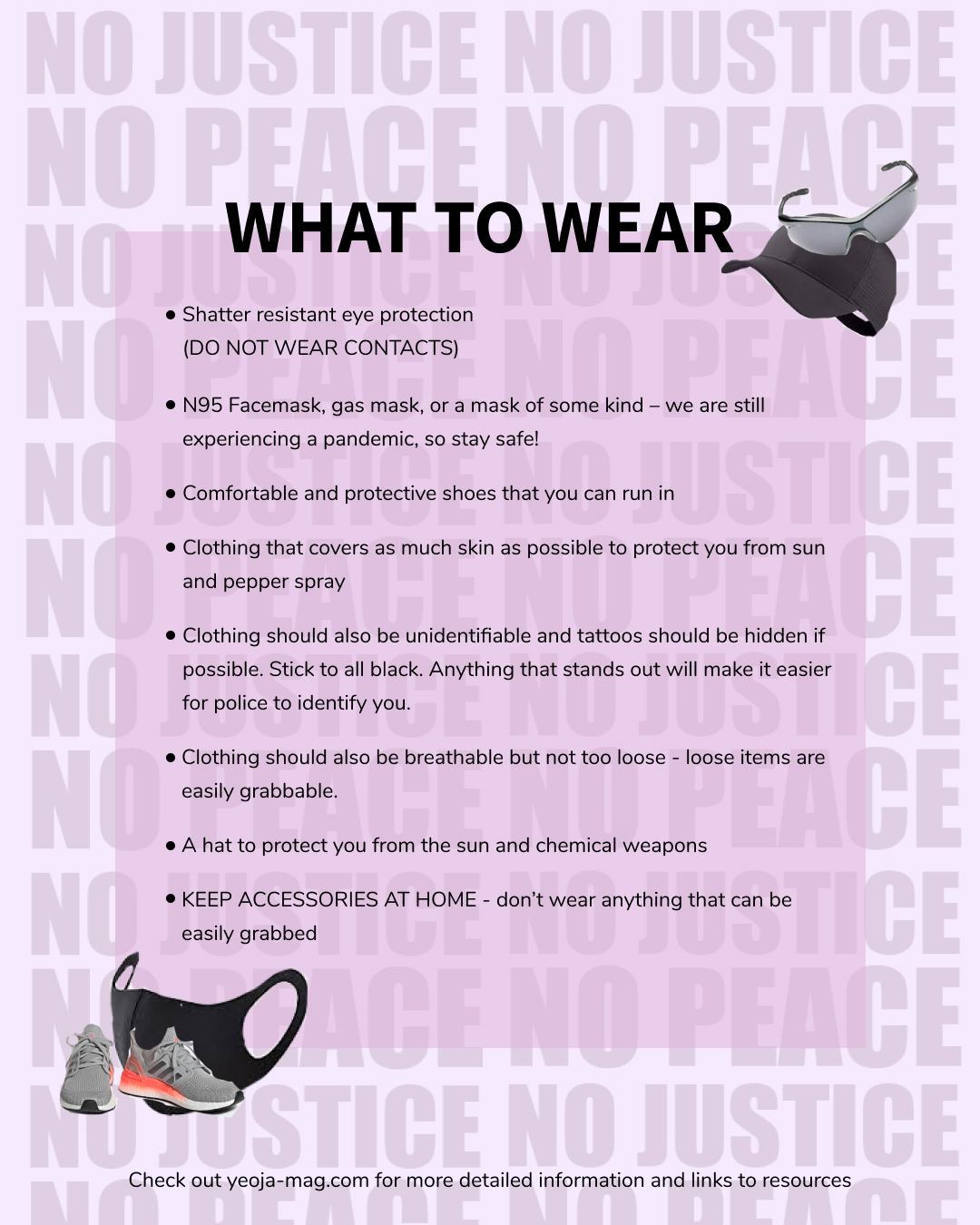
What to wear
- Shatter resistant eye protection (DO NOT WEAR CONTACTS)
- N95 Facemask, gas mask, or a mask of some kind – we are still experiencing a pandemic, so stay safe!
- Comfortable and protective shoes that you can run in
- Clothing that covers as much skin as possible to protect you from sun and pepper spray
- Clothing should also be unidentifiable and tattoos should be hidden if possible. Stick to all black. Anything that stands out will make it easier for police to identify you.
- Clothing should also be breathable but not too loose – loose items are easily grabbable
- A hat to protect you from the sun and chemical weapons
- KEEP ACCESSORIES AT HOME – don’t wear anything that can be easily grabbed
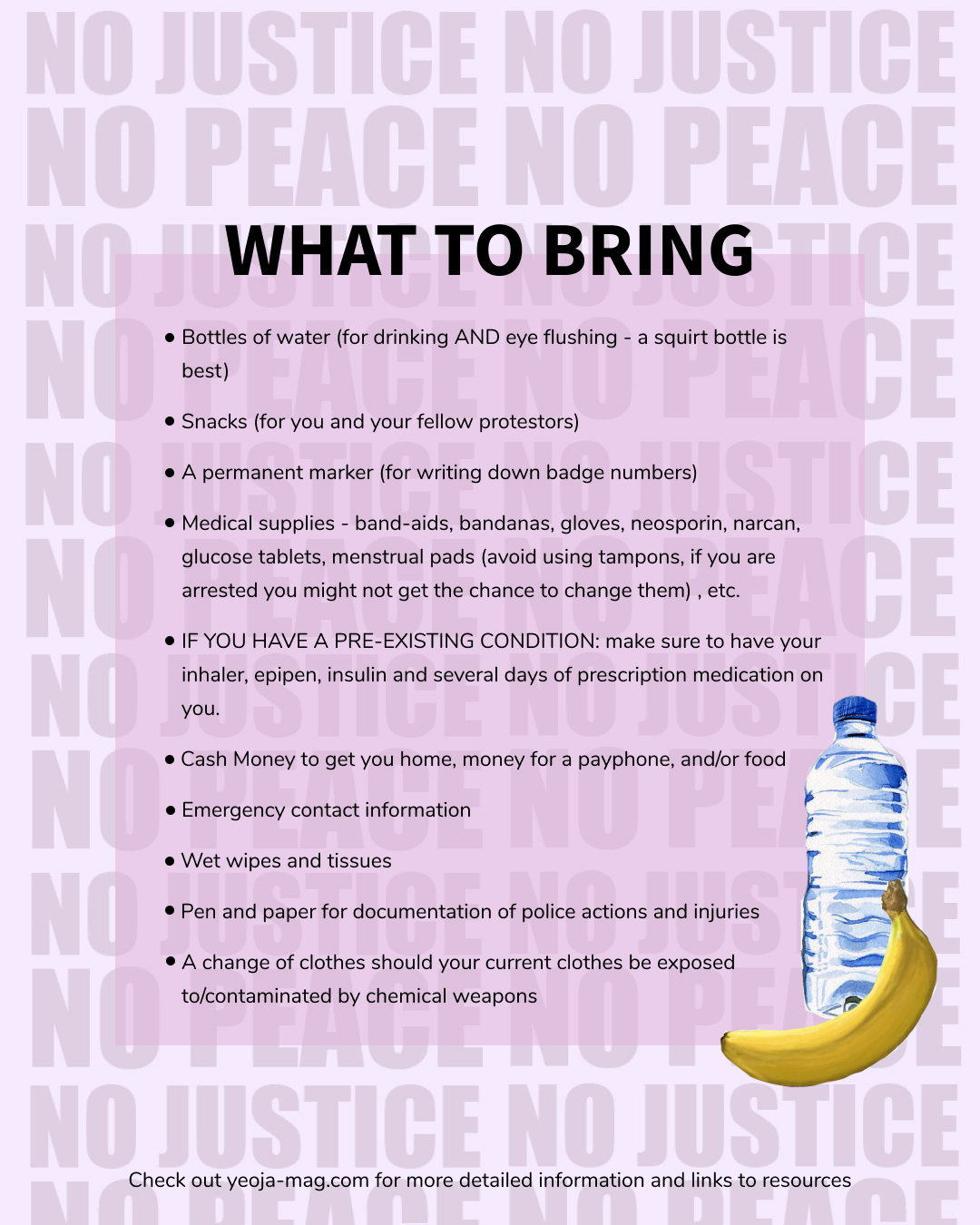
What to bring
- Bottles of water (for drinking AND eye flushing – a squirt bottle is best)
- Snacks (for you and your fellow protestors)
- A permanent marker (for writing down badge numbers)
- Medical supplies – band-aids, bandanas, gloves, neosporin, narcan, glucose tablets, menstrual pads (avoid using tampons, if you are arrested you might not get the chance to change them), etc.
- IF YOU HAVE A PRE-EXISTING CONDITION: make sure to have your inhaler, epipen, insulin and several days of prescription medication on you.
- Cash Money to get you home, money for a payphone, and/or food
- Emergency contact information
- Wet wipes and tissues
- Pen and paper for documentation of police actions and injuries
- A change of clothes should your current clothes be exposed to/contaminated by chemical weapons
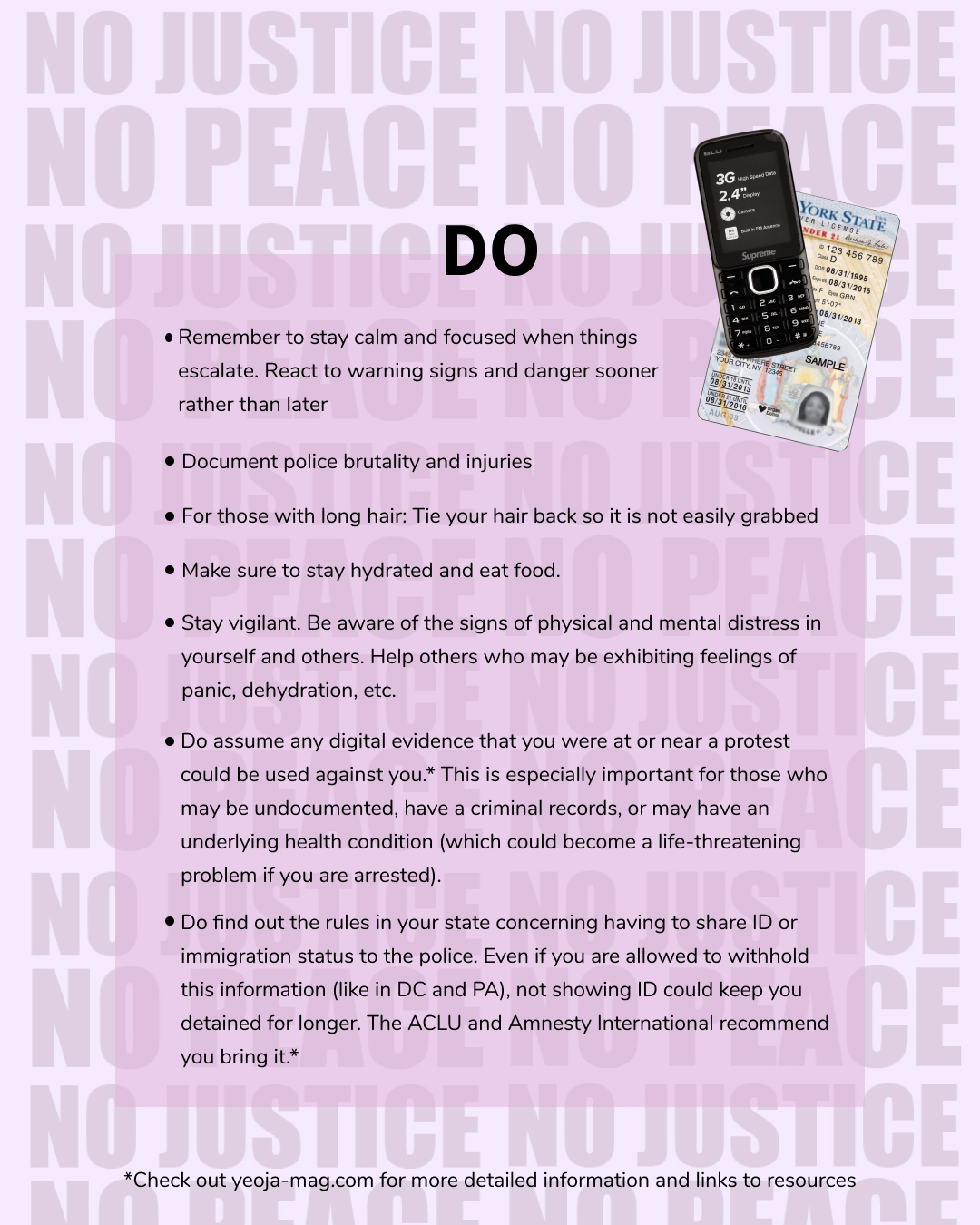
DO
- Remember to stay calm and focused when things escalate. React to warning signs and danger sooner rather than later.
- Document police brutality and injuries
- For those with long hair: Tie your hair back so it is not easily grabbed
- Make sure to stay hydrated and eat food
- Stay vigilant. Be aware of the signs of physical and mental distress in yourself and others. Help others who may be exhibiting feelings of panic, dehydration, etc.
- Do assume any digital evidence of you at or near a protest could be used against you. This is especially important for those who may be undocumented, have a criminal records, or may have an underlying health condition (which could become a life-threatening problem if you are arrested). Protect your Smartphone: It is up to you to make the decision to leave your phone behind or bring it with you. Law enforcement can force your mobile carrier to give up information recorded by cell towers: “This can give cops the individual mobile subscriber identity number of everyone at a protest at a given time, undermining the anonymity of entire crowds en masse.” Harlo Holmes, director of newsroom security at the Freedom of the Press foundation recommends protestors who want to remain anonymous leave their primary phone at home. If you have a cheap burner, bring this so that you are able to contact friends, family, or a lawyer in case of an emergency. If you do decide to bring your primary phone, keep it off as much as possible – this makes it harder for your phone to connect to rogue cell towers or Wi-Fi hot spots. You can also keep your phone in a Faraday bag which blocks all radio communications. (Read this article from WIRED for a more detailed look at this topic.)
- Do find out the rules in your state concerning having to share ID or immigration status to the police. Even if you are allowed to withhold this information (like in DC and PA), not showing ID could keep you detained for longer. The ACLU and Amnesty International recommend you bring it. For more information about ID please check out this article from Flex Your Rights.
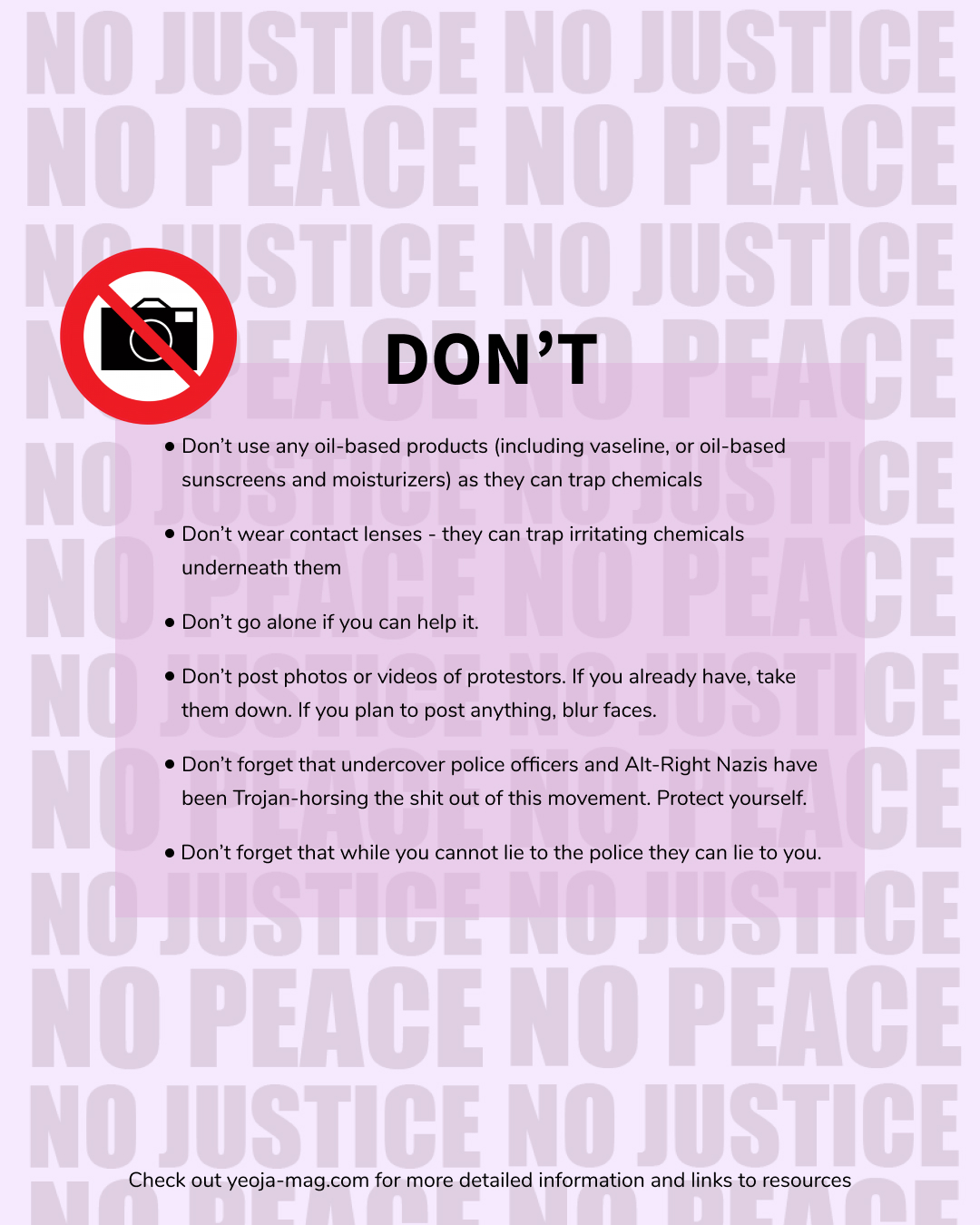
DON’T
- Don’t use any oil-based products (including vaseline and oil-based sunscreens and moisturizers) as they can trap chemicals
- Don’t wear contact lenses – they can trap irritating chemicals underneath them
- Don’t go alone if you can help it
- Don’t post photos or videos of protestors. If you already have, take them down. If you plan to post anything, blur faces.
- Don’t forget that undercover police officers and Alt-Right Nazis have been Trojan-horsing the shit out of this movement. Protect yourself.
- Don’t forget that while you cannot lie to the police they can lie to you.
How to deal with pepper spray (& tear gas)
- A bandana that is soaked in water, lemon juice, or vinegar can help aid in breathing should you be exposed to chemicals. Goggles can also help.
- Make your own tear gas/pepper spray neutraliser: Mix one parts antacid and one part water. Your antacid should include Magnesium Hydroxide or Aluminium Hydroxide. Avoid anything minty or that contains alcohol. (via @corinne.creating)
- STAY CALM: panicking will increase irritation. Breathe slowly and remember that what you are experiencing is only temporary.
- Clear your nose and mouth. Blow your nose and use water to rinse your mouth but do not swallow.
- If you or someone who has been attacked with a chemical is wearing contacts, remove them (or get them to remove them) with CLEAN, uncontaminated fingers. Flush both eyes with water. Repeat if necessary.
_
Download the pdf version here.
*This guide is meant to help anyone protesting, but is specifically tailored towards our American readers. For those protesting in other countries, please make yourself aware of the laws that dictate peaceful assembly in your country.
This guide has been put together with information from Amnesty International, the ACLU, and @corinne.creating.
Further reading: The Fat Protestor, How to Protest Safely in the Age of Surveillance
Original artwork created exclusively for YEOJA Mag by Katia Engell.



